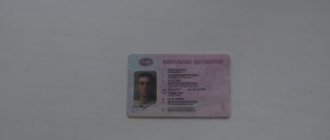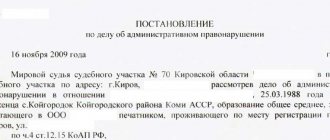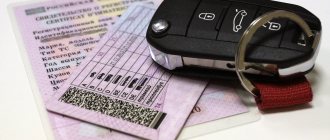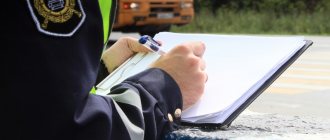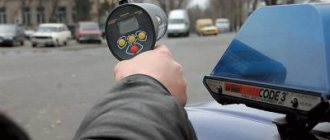According to Art. 3.8. The Code of Administrative Offenses, the current administrative legislation provides for such a measure of punishment for violators of traffic rules as the revocation of a special right. A driver’s license can be deprived only for serious or systematic violations of traffic rules and only in cases where the corresponding sanction is provided for by one of the articles of the Special Part of the Code of Administrative Offenses of the Russian Federation (that is, one of the articles of Chapters 5 - 21 of the Code of Administrative Offenses of the Russian Federation, for more details, see the picture). For example, for driving while intoxicated (Part 1, Article 12.8.), for leaving a railway crossing with a closed barrier (Part 1, Article 12.10.), for overtaking through continuous markings (Part 4, Article 12.15. ).
What is a petition for non-revocation of a driver's license?
A petition (hereinafter also referred to as a petition) for the non-application of such a sanction as deprivation of a driver’s license is understood as a written document submitted to the court by a citizen held accountable, containing a request to impose another punishment, regulated by the relevant article of the Special Part of the Code of Administrative Offences, indicating specific reasons and the circumstances supporting this request.
Attention! If you have any questions, you can chat for free with a lawyer at the bottom of the screen or call Moscow; Saint Petersburg; Free call for all of Russia.
Filing a petition for non-deprivation of a driver's license makes sense only if the case of an administrative violation is considered by the court. This is possible in two cases:
- if only the court has the authority to impose punishment for the relevant violation;
- or if the traffic police inspector has transferred the case materials for consideration to a judicial authority (below is a list of violations for which the inspector himself chooses - either to impose a punishment “on the spot”, or to transfer the case materials for consideration to the court).
In other cases, filing a petition for non-deprivation of a driver’s license does not make sense. Justification – in accordance with Art. 3.8. Code of Administrative Offenses, only a court can deprive rights. Therefore, if the justice body cannot consider a case of violation at all (see below for a list of such offenses), then under no circumstances can they confiscate the driving license.
That is, for such violations, as a rule, punishment is established either in the form of a warning or in the form of a fine and, on the basis of stat. 28.6. Code of Administrative Offences, the inspector in these cases simply draws up a resolution (without a protocol), hands over a copy with payment details and releases the driver.
Will I be satisfied or denied?
It depends on what exactly you are asking for, how and on what basis. But there are general rules. Refusal is only possible if motivated - that is, if a judge or inspector refuses to satisfy a request, they must legally explain why. If you ask for what the law provides you with, then they cannot refuse you.
In addition, depending on the types of “moves” there is a different probability of satisfaction:
- requests for legal assistance are rarely denied, since this possibility is prescribed by the Constitution, and employees are severely punished for violating it,
- if you ask to consider the case at your place of residence, then they may refuse, citing the fact that transferring the case to another city, district, region, and so on will interfere with a comprehensive study of the materials,
- when “moving” to impose a minimum sentence, replacing one sanction with another within the norms of the Code of Administrative Offenses of the Russian Federation, or issuing an oral remark, everything depends on the factors prescribed in the legislation and established judicial practice May 27, 2021,
- the situation is similar when applying for the restoration of the discount period on the fine - if you actually received a letter with a traffic police fine after 20 days from the date of the decision, then satisfaction will not be denied,
- nor has the right to refuse to admit your evidence or attract witnesses.
Normative base
The regulatory framework for filing a petition for non-deprivation of a driver’s license consists of the following articles of the Administrative Code:
| Link to article, part, paragraph of the Code of Administrative Offenses | A comment |
| Part 1 stat. 24.4., as well as part 1 stat. 25.1. | It says that the violator can file petitions, and they must be considered by the court. |
| Part 2 stat. 24.4. | It is indicated that petitions must be made in writing. The court will consider them immediately upon receipt. |
| Clause 6 stat. 29.1. | It is said that the judge, when preparing to consider the case, must check whether there are any submitted petitions and challenges. |
| Part 2 stat. 29.6. | It is said that the judge may extend the established two-month period for consideration of the case if any petitions are received from the participants in the process for non-deprivation of a driver’s license. |
Reasons for the need to submit a petition for non-deprivation of a driver’s license
A petition for non-revocation of a driver's license must be submitted only if the following are not disputed:
- the very fact of committing an administrative offense;
- actions of traffic police officials when recording a violation and drawing up a protocol;
- the presence of guilt of the citizen held accountable.
In other words, this petition is submitted if the driver agrees that he actually violated the traffic rules, but for one reason or another does not want to be punished in the form of revocation of the driving license.
For example, if activities related to driving a car are the main and only source of income, then deprivation of a driver’s license will put the driver in a difficult financial situation.
There may be other reasons for filing a petition, which are indicated in Part 2 of Art. 4.1. Code of Administrative Offenses, for example:
- property status of the perpetrator;
- the nature of the offense committed;
- the identity of the offender;
- the presence of circumstances mitigating liability.
How to write to apply to the magistrates' court?
So, it’s done and the case has been transferred to the magistrate, which means the prospect of taking away the driver’s license has become more real than ever. There is no single established form for such an appeal, but a petition to the court not to deprive a driver’s license in any case must contain:
- date and place of compilation;
- full name of the judicial authority;
- passport details of the person involved;
- when the offense occurred, the main circumstances;
- under what article are they going to deprive of rights;
- a request for non-deprivation of rights and replacement of punishment with another;
- signatures, seal.
If the employer submits the paper, then a letterhead with the organization’s logo is best suited for this; this gives the document greater credibility.
At what stage is a petition for non-deprivation of a driver's license submitted?
In Art. 24.4. The Code of Administrative Offenses does not say at what stage petitions should be submitted.
Judging from the meaning of the totality of regulatory provisions of the Code of Administrative Offenses, filing a petition for non-deprivation of a driver’s license can be done:
- starting from the moment the traffic police inspector fulfilled the obligation provided for in Part 1 of Art. 28.8. Code of Administrative Offenses - that is, transferred the case materials to the judge for consideration;
- and ending with the moment when the judge announces the decision on the case (Part 1 of Article 29.11.).
It is recommended not to delay and to submit an application for non-deprivation of a driver’s license while preparing for the consideration (clause 6 of Article 29.1.).
Rules for filling out an application for non-deprivation of a driver's license
The current administrative regulations do not regulate exactly how applications should be filled out. It only says that requests must be made in writing.
This means that there is no unified form. Therefore, it is recommended that a traffic violator draw up a petition for non-deprivation of a driver’s license on the basis of the rules that have developed and are applied in business practice when filing such applications.
The portal’s specialists have developed step-by-step instructions for filling out an application for non-deprivation of a driver’s license based on business rules:
- take a standard A4 sheet;
- we decide how exactly we will fill it out - by hand or using typewritten (computer) technology;
- we draw up a “header” in which we indicate the name of the court where the document is being submitted, the full name of the person held accountable, and the number of the administrative case pending in this court;
- in the center we write the name of the document - that is, “Application for non-deprivation of a driver’s license”;
- further we describe the situation in detail - the date, time of the violation, its essence, link to the paragraph, part, article of the Code of Administrative Offenses, full name of the traffic police inspector who recorded the offense, details of the state registration plate, details of the drawn up protocol, make and model of the car and other data;
- then we write a clear agreement with the charges brought, that is, there is no need to dispute the very fact of the violation, the actions of the traffic police officers, etc.;
- We indicate a list of reasons due to which the driver should not be deprived of his license (for example, the presence of several young children, a difficult financial situation, an indication that the car is the main source of income, etc.);
- then in the center we put the word “I ask” and write a request to the court not to deprive the driver of the right to license, but to impose such and such a punishment (for example, administrative arrest);
- Finally, we enter the date of the application, signature and transcript.
You can ask for such and such a punishment if it is provided for in the relevant article. For example, for leaving the scene of an accident in accordance with Part 2 of Art. 12.27. provided:
- or deprivation of rights from 1 to 1.5 years;
- or administrative arrest for up to 15 days.
Accordingly, in this case it is necessary to apply for an arrest.
Or, for example, you can apply to replace the deprivation with an administrative fine (see, for example, Part 1 and Part 2 of Article 12.24 of the Administrative Code).
general information
First, it’s worth understanding the terminology.
“Petition” in this case means submitting to the court a package of documents that will help convince the servants of the law to commute the punishment. The person who applies automatically admits his guilt and has no claims regarding the classification of the offense committed.
Why a driver can be deprived of his license:
- for driving a vehicle with false plates;
- for driving into the oncoming lane;
- for equipping a vehicle with special devices without obtaining the appropriate permission;
- for speeding;
- for failure to give priority to a vehicle with a flashing light or a special signal on;
- for committing an accident with victims;
- for leaving the scene of an accident;
- for failure to comply with the rules for crossing railway crossings.
It is also unlikely that it would be reasonable to apply if the violation of traffic rules entailed serious consequences, such as a violation of the safety of citizens.
However, if the driver was not drunk at the time of the offense, and his actions did not cause harm to the health of citizens, if he was forced by circumstances, for example, to drive beyond a double line to avoid an accident, then filing a petition would be quite appropriate.
The situation can be alleviated by the fact that the main source of a citizen’s income is related to his driving activity. The court may take this into account and reduce the punishment.
You can also submit a petition for non-deprivation of rights and mitigation of punishment to the driver in the following cases:
- the case under consideration, which was opened due to an offense, has expired;
- deprivation of a driver's license entails a significant deterioration in the quality of life not only of the accused himself, but also of the persons who depend on him;
- the medical examination (if it is really necessary in this situation) was carried out without following the established rules;
- witness statements were not taken into account without good reason.
To complete the picture, you need to find out how a driver’s license is revoked:
- An employee of the State Traffic Inspectorate stops a vehicle in which an offense was committed (improper maneuver, dangerous movement or overtaking, for example). If an accident occurs, then this point, of course, is not taken into account: law enforcement officers are called to the scene of the accident.
- Draws up a protocol. The protocol must contain the signatures of the participant(s) in the incident, as well as the person who compiled it, and witnesses. All objections of the participant(s) in the accident must also be recorded in the document. The original remains with the traffic police, and copies can be obtained upon request. It is important to personally check all entries made in the protocol. If it contains information with which the driver does not agree, but he signed it, then in the future it will be very difficult for him to defend his case.
- The documents collected regarding this offense are sent to the traffic police.
- The administrative commission determines the punishment and decides whether to deprive the driver of his license or limit himself to paying a fine. She is given a period of 3 to 15 days to decide what punishment to apply to the driver.
- If the commission decides to revoke the driver's license, the case is sent to the magistrate's court, where the judge makes the final decision.
- If the court orders the driver to be deprived of his license, then the latter must either surrender his license to the traffic police department or file an appeal.
The period of deprivation of a driver's license should be counted from the day on which they were submitted to the automobile inspection.
At any of the stages described in the six points, you can apply. Another question: is it worth doing? It follows from practice that judicial authorities often side with traffic police officers, but this does not mean that there is no need to even try.
If the application is submitted to the traffic police, then the following features must be taken into account:
- The document must be addressed to the head of the traffic police department.
- The petition is drawn up in any form, but must contain the information that will be listed below.
An approximate template for drawing up a petition to the traffic police for non-deprivation of rights (sample) can be found in the public domain.
How to increase the chances of a positive outcome for the driver? Request and then attach to the case a reference from the place of work (positive reference).
The characterization will have an even greater effect if the work involves driving a vehicle: the removal of such a valuable employee from the professional activities will seriously affect the work of the entire organization as a whole.
When a driver commits an offense that is recorded by a traffic police inspector, the latter must draw up a report and assign a penalty.
But when deprivation of rights is expected, the police officer only documents the fact and recommends punishment regulated by the article of the Code of Administrative Offenses of the Russian Federation. The main decision is made by the court, and if you try, you can justify yourself, although you need reasons for this.
According to the law, a person accused of an offense can maintain his innocence by all legal means.
One of these methods is to submit a petition to the court involved in the consideration of a particular case.
But this will not always work, so you should understand the situations when the application will work, and when it is not even worth trying to submit it.
Required terms
| Term | Meaning |
| Petition | An official document in the form of a statement in which a person puts forward a demand, request, or insists on a certain decision |
| traffic police | The police unit that monitors the situation on the roads identifies offenses and the drivers who committed them. In addition, the list of functions of the traffic police also includes examination of future drivers and confirmation of their qualifications |
| Deprivation of rights | A measure of administrative punishment, when used, the driver’s license is taken away for a period specified in a court decision. He has no right to drive a car, and if he is caught doing this, the punishment will increase |
An application related to a request not to deprive a driver of a driver’s license can also be submitted at different stages, but you should find out at which stages.
| Preliminary investigation | It is carried out at the State Traffic Safety Inspectorate, and at this stage the head of the inspection department or a special commission considers the appeal |
| Bringing the case to court | If the materials have already been submitted to the court, then the petition should be submitted to the judge, who decides whether to grant it or deny it |
| After making a decision | Even if the decision has already been made, the driver can file an appeal and submit a petition during the appeal |
Legal basis
All traffic-related violations that involve deprivation of rights as punishment are collected in Chapter 12 of the Code of Administrative Offences.
Also, applications are submitted in free form, since the standard form has not been approved. And the same Code of Administrative Offenses and its Article 24.4 states that applications must be submitted in writing or orally.
Mitigating circumstances, which may be a reason for reducing the punishment and a decision not to deprive of rights, are prescribed in Article 4.2 of the Code of Administrative Offenses of the Russian Federation.
Sample of filling out an application for non-deprivation of a driver's license
The portal's lawyers have developed a sample application form for non-deprivation of a driver's license in WORD format. All you need to do is enter the required data in the appropriate fields (an explanation of what exactly needs to be written is indicated below these fields), and then print.
Institutions for filing a petition for non-deprivation of a driver's license
In accordance with the last paragraph of Part 3 of Art. 23.1. Administrative Code, most cases related to traffic violations are considered by magistrates. Only in certain cases can a case be referred for consideration:
- district court (for example, if an employee of the Investigative Committee violated traffic rules - paragraph 2, part 3, article 23.1 of the Administrative Code);
- arbitration court (see paragraph 4 and paragraph 5 of part 3 of article 23.1 of the Administrative Code).
As for geographical and territorial jurisdiction, the case is considered (in general) at the place where the offense was committed (Part 1 of Article 29.5 of the Administrative Code). But if the violator submits a corresponding petition, they may also consider the driver at the place of residence.
Required documents for filing an application
The application for non-deprivation of a driver's license must be accompanied by documents that confirm the circumstances listed by the violator in the text of the document, according to which it is better to replace the deprivation with another type of administrative punishment.
Of course, a unified package of documents has not been approved, since it will vary depending on the specific case and circumstances. Here is an approximate list of necessary documents for filing a petition for non-deprivation of a driver’s license:
- a copy of the offender’s passport;
- a copy of the violation protocol drawn up in accordance with Art. 28.2.Administrative Code;
- characteristics from the place of work, study, residence, signed, respectively, by the head of the production, educational organization or housemates;
- certificates from medical organizations confirming the presence of relatives with serious illnesses and requiring constant care;
- documents confirming the presence of mitigating circumstances (for example, a certificate of pregnancy or a woman has a young child - clause 10, part 1, article 4.2 of the Administrative Code);
- papers certifying the compensation for damage caused by an offense (for example, about voluntary payment of moral damages in favor of a hit pedestrian - stat. 12.24. Code of Administrative Offences);
- other documents that, in the opinion of the offender, may prompt the court to make a decision not to impose deprivation of rights, but another punishment provided for in the relevant article.
Procedure for imposing punishment
The document must contain the necessary details, including the signatures of the person (traffic police inspector) who compiled it, the participants in the accident, as well as the witnesses present when the document was executed. If a participant in an accident has objections or comments regarding the material set out in the protocol, such information is also recorded in the text of the document. After drawing up the protocol, the original document remains with the traffic police inspector, copies are received by the participants in the accident upon their request;
If the sanction of a violated article provides for the possibility of choosing a punishment, for example, a fine or deprivation of rights, the commission examines the elements of the offense and makes a decision. In this case, the presence of aggravating and mitigating circumstances may be taken into account. If a decision is made to impose penalties, a resolution is drawn up and sent to the offender for subsequent execution.
Important! The beginning of the calculation of the sentence is the moment the certificate is confiscated by the traffic police. The driver is obliged to voluntarily hand over his license if the court makes an appropriate decision.
Step-by-step instructions for filing a petition
The entire procedure from stopping the car by a traffic police inspector, recording the offense and until the final decision is made is as follows:
- initiation of a case (Article 28.1 of the Administrative Code);
- drawing up a protocol by the traffic police official who recorded the offense (Article 28.2.) (this is done immediately after the violation is detected - Part 1 of Article 28.5.);
- handing over a copy of the protocol to the violator;
- sending the protocol for consideration to a judge within 3 days (Part 1 of Article 28.8.);
- submission by the violator of a written petition for non-deprivation of a driver’s license (for how to draw up samples, see above in the article) to the magistrate’s court located at the place where the violation was committed (or at the driver’s place of residence, if a corresponding petition was submitted);
- if the petition is rejected, a ruling is issued; if it is not rejected, then the ruling is not issued (Part 2 of Article 24.4.).
Regardless of whether the application for non-deprivation of a driver’s license is rejected or not rejected, the consideration of the case will be carried out in the general manner and within the time limits specified in Chapter 29 of the Code of Administrative Offenses, that is:
- preparation for consideration is being carried out (stat. 29.1.);
- the circumstances preventing the consideration of the case by the appointed judge are checked (Article 29.2.);
- a date and time are set for the meeting;
- Testimony of the offender, witnesses, and other persons participating in the process is heard (Part 2 of Article 29.7.);
- a date and time are set for the announcement of the decision on the case (the decision can be in one of two types - either on the imposition of punishment or on release from liability - Part 1 of Article 29.9.).
Requirements for filing an application
Contents of the application sample:
- name of the authority to which the application is sent (traffic police, court);
- place, time and date of the incident;
- data of the traffic police inspector who issued the protocol;
- the presence of mitigating circumstances;
- information about the violated article of the Code of Administrative Offenses, as well as an alternative punishment;
- justification of the reason for canceling the punishment in the form of deprivation of rights. For example, the lack of a license deprives the driver of the opportunity to earn a living, perform official duties, or move around (disabled);
- request to replace the penalty by imposing a fine;
- evidence base;
- date and signature of the applicant.
Correct execution and content of the application is the key to its acceptance and successful resolution of the issue. The document must contain the following information:
- name of the organization to which the document is addressed;
- factual data on the committed traffic violation (date, time, place of occurrence, name of the traffic police inspector who issued the protocol, imputed article of the Code of Administrative Offenses, providing for alternative penalties, factors of the incident and circumstances conducive to mitigation of punishment);
- compelling reasons for the application (a car is the only source of income, the only means of transportation for a disabled person, deprivation of rights may lead to dismissal from work or entail additional financial expenses, etc.);
- a clear formulation of the request to replace the penalty in the form of deprivation of rights to a fine;
- a list of evidentiary documents supporting the request, attached to the application;
- date of filing and signature of the applicant (the application can be submitted on behalf of the organization where the applicant works or studies, then it must be issued on company letterhead, signed by the head and certified by the seal of the organization).
The document should not contain unfounded conclusions, assumptions and recommendations. However, it can make reference to legislative and regulatory acts that substantiate the applicant’s request.
Decision-making
After the expiration of the established two-month period (Part 1.1. Stat. 29.6. Code of Administrative Offenses), the court makes a decision (except for cases where the period was extended in accordance with Part 2 of Stat. 29.6.).
If the court decided to impose a punishment (that is, the guilt of the offender was established), then the decision will indicate a reasoned decision in the case (clause 6, part 1, article 29.10.).
The traffic violator will learn that the request not to revoke his driver’s license was granted only when the final verdict is announced. Of course, the court will also indicate in its ruling what it was specifically guided by when deciding to deprive of rights or impose another punishment.
Note that the court makes a decision in accordance with the general rules for imposing sanctions specified in Art. 4.1. Code of Administrative Offences. That is, the petition of the violator is not the only circumstance that entails the possibility of imposing one or another sanction. This petition may not be filed, but the court will rule on non-deprivation. The opposite is also true - the petition was granted, but the court did not take it into account and nevertheless ordered the revocation of the license (for example, if the arguments stated by the violator are insignificant or are not supported by relevant evidence).
How is the procedure for revocation of a driver's license carried out?
Stage 1. The inspector who stopped the violator’s car draws up a violation report, which is signed by him, the driver and two witnesses. If there are no witnesses, then a video recording must be made. If the driver does not agree with the inspector’s decision, he must record his reasonable objections in the protocol.
- An administrative fine is imposed, in such cases it is usually 5,000 rubles, but the person’s driver’s license is not deprived. In this case, a resolution on violation of traffic rules is drawn up, a copy of which is sent to the violator.
- A decision is made to revoke the driver's license and the case is sent to court.
In addition, at the request of the violator, the case may be transferred for consideration to another traffic police department at his place of residence. A period of 3 days is given to make this decision. The deadline for consideration of the case by an official at the traffic police department is 15 days.
Stage 3. If the case goes to court, it is heard by a magistrate. By law, the case must be considered within 2 months from the date of receipt of the protocol. The court may also replace deprivation of rights with a fine. However, the practice of trials shows that the court most often takes the side of law enforcement officers.
Then the driver is obliged to voluntarily surrender his driver’s license to the traffic police department. The period of deprivation of rights begins to count from the day the certificate is handed over to the traffic police. At this stage, the driver can file a petition with the court not to deprive him of his license. If the court decides to impose a penalty in the form of a fine, then it issues a corresponding resolution, a copy of which is given to the driver.
Before considering the specifics of the procedure, it is necessary to dwell in more detail on the grounds for applying this penalty and the procedure for its implementation.
The decision to deprive a driver’s license is made by the court in cases provided for by the Code of Administrative Offenses of the Russian Federation. This penalty is the most severe and is assigned for gross violations of traffic rules.
Grounds for revocation of a driver's license:
- driving a vehicle with or without false signs;
- driving into the oncoming lane;
- equipping a car with illegal devices installed without appropriate permission;
- exceeding the speed limit for a given section of the road by more than 60 km/h;
- not giving priority in traffic to a special vehicle with the sound signal on;
- committing a traffic accident with victims;
- leaving the scene of an accident by a participant;
- violation of the rules for crossing a railway crossing.
Nuances
When filing a petition for non-deprivation of a driver’s license, the driver should take into account some nuances:
- if the relevant article of the Code of Administrative Offenses provides for unalternative deprivation of rights (for example, when overtaking repeatedly through a continuous line - Part 5 of Article 12.15.), then it makes no sense to submit a request for non-deprivation - it is the very fact of the violation that should be challenged, that is, to prove innocence;
- in the cases specified in Part 2 of Art. 23.1., the inspector himself decides whether to transfer the case to court or impose a fine on the spot - accordingly, a kind of “petition” that he does not transfer the case materials to the court should be submitted to the inspector (in other words, ask him to impose a fine);
- sending the case to court in accordance with Art. 28.8. does not mean that the justice authority will impose deprivation of driving license (for example, an article of the Code of Administrative Offenses provides for either a fine or deprivation of a driver’s license, but the inspector decides not to impose a fine, but to send the case to court, this does not mean that the court will now specifically impose deprivation - quite possibly a fine);
- if the petition for non-deprivation did not help, and the driver’s driving license was nevertheless revoked, all is not lost - the court’s decision can be appealed in the standard manner provided for by Chapter 30 of the Code of Administrative Offences.
